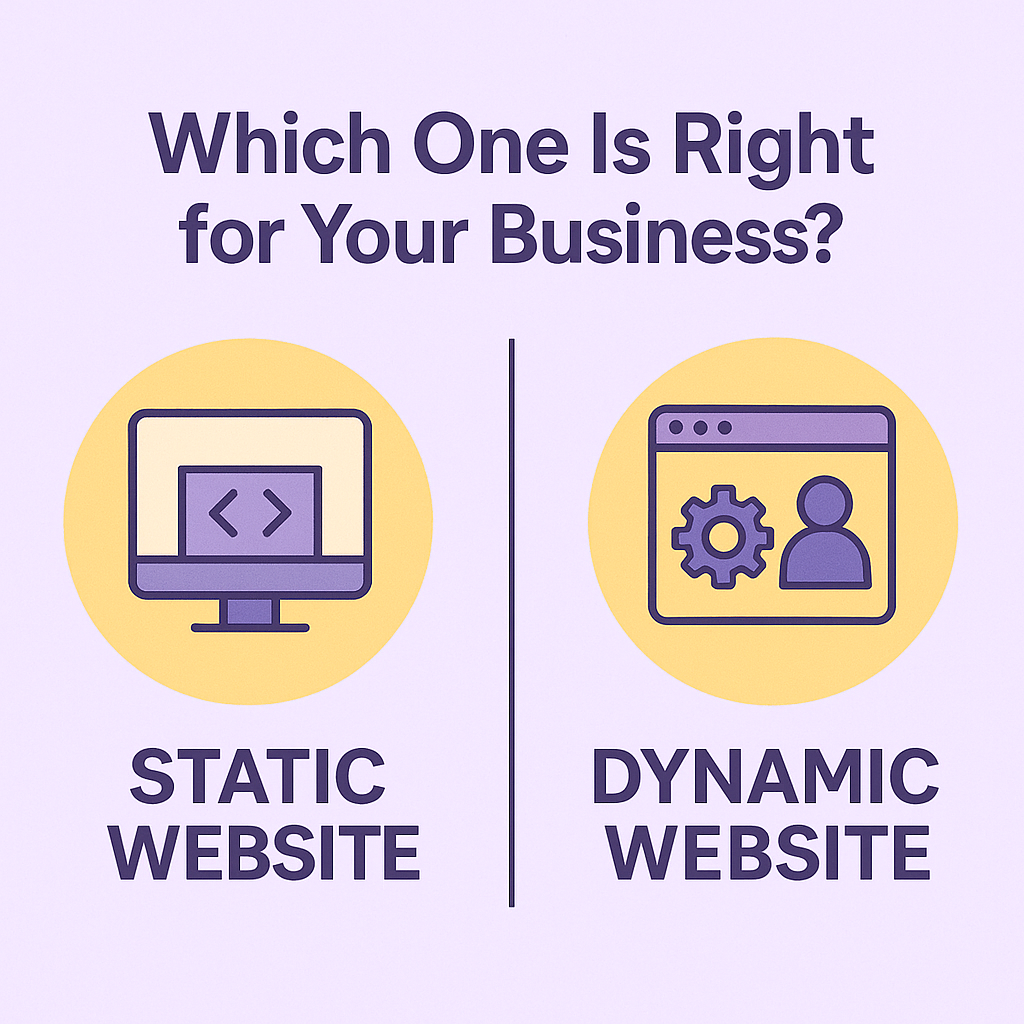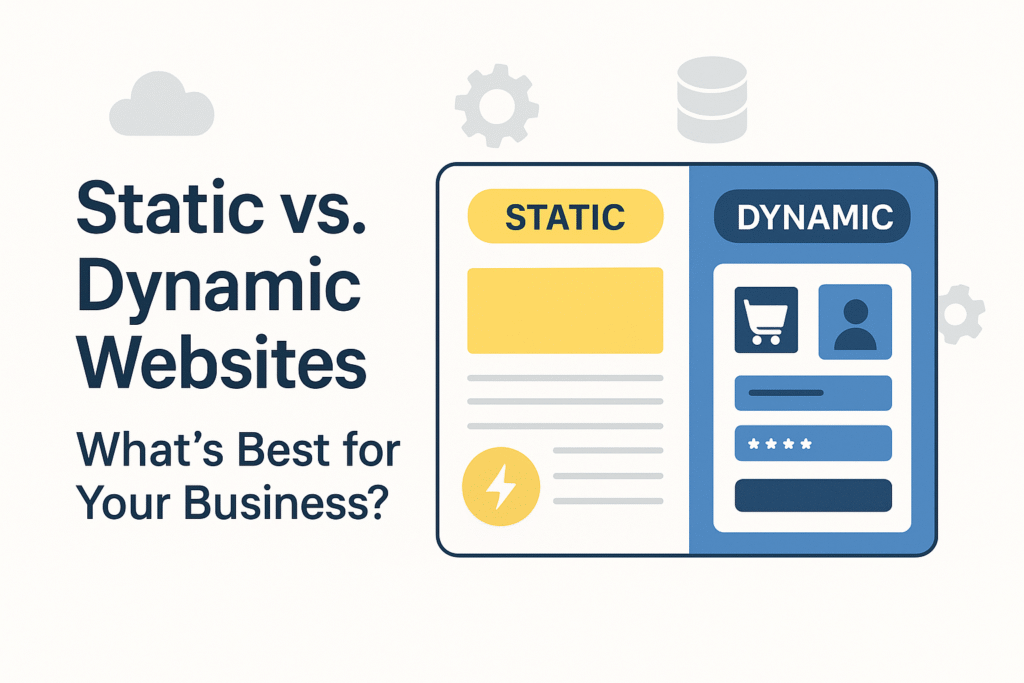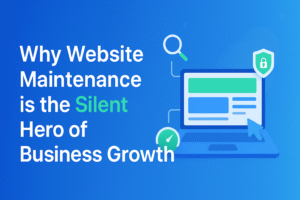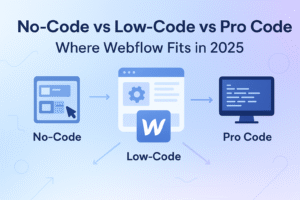Introduction
In today’s fast-paced digital world, your website is often the first impression customers have of your business. Whether you’re a startup, small business, or established brand, the type of website you choose, static or dynamic, can significantly impact your online presence, performance, and growth potential.
But with so many options available, how do you decide which one fits your needs?
This guide will help you understand the difference between static and dynamic websites, how they function, their pros and cons, and most importantly, which one aligns best with your business goals.
Whether you’re planning a new website or thinking about redesigning your current one, understanding static vs dynamic website structures is key to making an informed decision that supports scalability, SEO, user experience, and budget.
What Is a Static Website?
A static website is made up of fixed web pages that are delivered to the user’s browser exactly as stored. Each page is coded in HTML and CSS, and it doesn’t change unless a developer manually updates the code. These websites do not fetch data from a database, meaning the content remains the same for every visitor unless it’s updated manually.
Static websites are often used for small businesses, portfolio sites, brochure-style pages, or any website that doesn’t require real-time content changes.
Key Features of Static Websites
- Fixed content that stays the same for all users
- Faster loading times due to simple HTML/CSS files
- Lower hosting costs since there’s no need for server-side processing
- Easier to secure because there are fewer components vulnerable to hacking
- Ideal for simple websites with limited content updates
Pros of a Static Website
- Very fast performance, even on slow connections
- Minimal maintenance required
- Lower development and hosting costs
- Great for websites with fewer than 10 pages
- Simple to launch quickly, especially with static site generators like Jekyll or Hugo
Cons of a Static Website
- Not ideal for sites that require frequent content updates
- Lacks user interactivity (e.g., no search functionality or login systems)
- Updates require knowledge of HTML or a developer’s help
- Cannot easily integrate with dynamic content like blogs, news feeds, or user data
When Should You Use a Static Website?
A static website is a good choice for businesses that need a fast, affordable, and reliable online presence without frequent content changes. It’s ideal for:
- Personal portfolios
- Small business landing pages
- Event or product launch pages
- Informational sites with limited content updates
SEO and Technical Benefits for Static Websites
Static websites offer several advantages in terms of speed, security, and search engine optimization—especially for small businesses and startups. Here’s how they benefit your website’s performance and SEO:
- Faster Load Speeds
Static sites load quicker because they serve pre-built HTML pages without server-side processing. Since page speed is a Google ranking factor, faster sites often rank higher. - Stronger Security
With no backend databases or dynamic scripting, static sites have fewer vulnerabilities, making them more secure against common cyber threats. - Low Maintenance and Hosting Costs
Static sites can be hosted on low-cost servers or CDNs (like Netlify or GitHub Pages), require less maintenance, and are easier to manage for non-technical users. - Better Crawlability and Indexing
Search engines can easily crawl static sites as the content is directly available in the source code—no dynamic rendering delays, leading to better indexing. - Handles High Traffic Efficiently
Static sites put minimal load on the server, making them ideal for handling spikes in traffic without slowing down or crashing. - Globally Fast via CDN
They integrate well with CDNs, ensuring faster load times for visitors across different regions—enhancing both user experience and SEO reach.
What Is a Dynamic Website?
A dynamic website is one where the content is generated in real-time and can change based on user interaction, preferences, or data stored in a database. Unlike static websites that display the same content to every visitor, dynamic websites display customized content depending on factors like user location, login status, or browsing behavior.
Dynamic websites rely on server-side scripting languages like PHP, Python, or JavaScript (Node.js) to fetch data from a database and generate content on the fly. Popular platforms like WordPress, Shopify, and eCommerce websites are dynamic in nature because they offer interactivity and real-time content updates.
Key Features of Dynamic Websites
- Content is generated in real-time based on user actions or backend data
- Often connected to a database for managing content or user accounts
- Supports features like search functionality, login systems, forms, shopping carts, and more
- Easier content management through CMS platforms like WordPress or Shopify
- Can display personalized content for different users
Pros of a Dynamic Website
- Easy to update content without touching the code, especially with a CMS
- Scalable for large websites with hundreds or thousands of pages
- Allows advanced functionality like blogs, product catalogs, and user logins
- Better suited for businesses that grow or update content regularly
- Enhances user engagement through personalized experiences
Cons of a Dynamic Website
- Slightly slower load time compared to static websites, depending on hosting and optimization
- Higher development and hosting costs
- More complex to secure due to the use of databases and scripts
- Requires more maintenance and regular updates
When Should You Use a Dynamic Website?
A dynamic website is the best choice if your business needs frequent updates, user interaction, or complex functionalities. It’s perfect for:
- eCommerce businesses using platforms like Shopify or WooCommerce
- Content-rich websites like blogs, news portals, or online magazines
- Businesses offering personalized services or dashboards
- Educational platforms or course management systems
- Membership sites or client portals
SEO and Technical Benefits of Dynamic Websites
Dynamic websites come with strong SEO and technical advantages—especially for businesses aiming to scale or frequently update their content.
- Easier Content Updates
Dynamic websites use CMS platforms like WordPress or Shopify, making it simple to add blogs, products, or service pages—keeping content fresh and SEO-friendly. - Personalized User Experience
They allow customized content based on user data like location or behavior, which boosts engagement and lowers bounce rates—good for SEO. - Scalable and Search-Friendly
Large websites with hundreds of pages benefit from dynamic structures. You can manage unique URLs, metadata, and structured data easily, helping search engines crawl your site effectively. - Built-in SEO Tools
Platforms support powerful SEO tools like Rank Math, Yoast SEO, or Shopify apps to automate meta tags, sitemaps, schema markup, and more. - SEO-Friendly URLs
Dynamic sites generate clean, optimized URLs automatically for products, categories, or blog posts—improving ranking potential. - Analytics and Tracking Integration
They easily connect with Google Analytics, Search Console, and heatmaps, helping you monitor traffic and fix SEO issues. - International SEO
You can serve region/language-specific content using tools like WPML (for WordPress) or Shopify Markets, supporting global SEO strategies. - Mobile and Speed Optimization
Dynamic platforms usually offer responsive designs and tools to meet Google’s Core Web Vitals standards—important for mobile SEO.
📊 Key Differences Between Static and Dynamic Websites
| Factor | Static Website | Dynamic Website |
|---|---|---|
| Definition | Fixed content; each page is manually coded | Content generated dynamically with database interaction |
| Content Updates | Manual, time-consuming | Easily updated via CMS (e.g., WordPress, Shopify) |
| User Experience | Same for all users | Can be personalized based on user behavior or location |
| Scalability | Limited and harder to manage as it grows | Highly scalable and flexible |
| Speed & Performance | Very fast loading times | Slightly slower but optimized with caching & CDNs |
| Development Cost | Generally lower for small projects | Higher due to backend setup and CMS integration |
| SEO Capabilities | Basic SEO setup possible | Advanced SEO features and tools available |
| Best For | Brochure sites, portfolios, landing pages | E-commerce, blogs, large or interactive business sites |

✅ Choose a Static Website if:
- You offer a brochure or portfolio site with fixed content
- You prefer speed, simplicity, and low cost
- You want better initial SEO advantage with minimal maintenance
✅ Choose a Dynamic Website if:
- You need features like user accounts, blogs, product listings, or interactivity
- You want a robust content management system (WordPress, WooCommerce)
- You plan ongoing updates and expansion
🔍 SEO Best Practices in 2025
For Static vs. Dynamic Websites
🧱 Static Websites
✅ Lightweight & fast-loading — Google loves speed
✅ Manual meta tags and keyword-rich content
✅ Mobile-friendly, responsive design which helps search engines
✅ Add Schema Markup (like FAQ, Breadcrumbs)
✅ Use clean, semantic HTML for better indexing
✅ Great for small business, for portfolio, or for landing pages
⚙️ Dynamic Websites
✅ Use Server-Side Rendering (SSR) for SEO crawlability
✅ Sitemaps to help search engines navigate content
✅ Clean URLs with unique content, avoid parameter clutter
✅ Apply structured data to dynamic elements
✅ Use caching & CDNs to maintain performance
✅ Ideal for eCommerce, blogs with frequent content updates
🔍 Conclusion: Static vs. Dynamic – What Fits Your Business?
Your website should reflect your business goals and how you plan to grow.
Static websites are fast, secure, and cost-effective—ideal for portfolios, brochures, or businesses with minimal updates.
Dynamic websites offer flexibility, interactivity, and real-time updates—perfect for eCommerce, blogs, or platforms with frequent content changes.
Choose the right structure based on your business needs, budget, and future scalability.
🚀 Ready to Build a Website That Works for Your Business?
Whether you need a fast static site or a powerful dynamic platform, our team specializes in:
- Web design & UI/UX
- Shopify & WooCommerce development
- Custom WordPress solutions
- SEO-optimized web architecture
📞 Let’s create a website that delivers results.
👉 Contact us today for a free consultation or visit our services page to get started!
FAQs
1. What is the difference between static and dynamic website?
A static website delivers the same content to all users, while a dynamic website generates customized content based on interactions, databases, or user roles.
2. Are static websites better for SEO?
Yes, static websites can perform well in SEO due to fast load times and clean code. However, dynamic sites can also be SEO-friendly with the right structure and plugins.
3. When to choose static vs dynamic website?
Choose a static website for simple projects. Go with dynamic if you need content updates, login features, or eCommerce functionalities.
4. What are dynamic website features for eCommerce?
Dynamic sites offer product filtering, customer accounts, cart systems, CMS integration, and personalized recommendations—perfect for online stores.
5. Can I convert my static website into dynamic later?
Yes, developers can upgrade static sites into dynamic ones by integrating CMS platforms or backend scripting.











